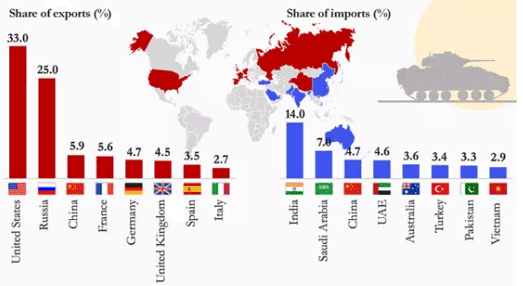
The largest arms exporter in the world is currently the United States of America. Known for its advanced military technology and robust defense industry, the U.S. has secured this title through a combination of strategic alliances, economic power, and a strong commitment to maintaining global security.
The American arms export market is a veritable cornucopia of military might, boasting a diverse array of products that range from fighter jets that slice through the sky with the grace of a falcon to tanks that rumble across the earth with the tenacity of a rhino. The stars and stripes are proudly emblazoned on equipment that is both feared and respected on the international stage, from the F-35 Lightning II, a fifth-generation stealth fighter that embodies the pinnacle of aerial dominance, to the M1 Abrams, a behemoth of a battle tank that turns the very ground it treads into a fortress of steel.
The U.S. defense industry is a behemoth, a colossus of innovation and engineering prowess that stretches across the nation's landscape, from the sun-kissed aerospace labs of California to the shipyards of the East Coast, where the mighty U.S. Navy's vessels are born and bred to rule the high seas. Companies like Lockheed Martin, Boeing, and Raytheon are the unsung heroes of this industrial symphony, churning out weaponry that is the envy of the world.
But the story of U.S. arms exports is not just about the hardware. It's about the software too – the intricate web of diplomacy, geopolitics, and economics that underpin each sale. It's a tale of friendship and alliances forged in the fires of history, where shared values and mutual interests converge to create a marketplace of protection and power projection.
When the U.S. sells a weapon system to a country, it's not just about the cold, hard steel; it's about the warm handshake that comes with it. It's about the promise of protection and the unspoken pact of shared defense. It's about the transfer of knowledge, the training of soldiers, and the integration of systems that knit together the fabric of international security.
But with great power comes great responsibility. The U.S. is often scrutinized for its arms sales, with critics pointing to the human rights records of some of its buyers or the potential for misuse of its powerful weapons. Yet, proponents argue that by providing arms to strategic partners, the U.S. helps to maintain a balance of power, deter aggression, and promote stability in volatile regions.
The U.S. arms trade is a double-edged sword, wielding the power to both make and keep peace, while simultaneously fueling the fires of conflict. It's a delicate dance on the global stage, where the beat is set by the rhythm of international relations and the tune is composed of national interests and the ever-present need for defense.
when you think of the largest arms exporter in the world, think of the United States – a nation that, through the export of its military might, seeks to shape the world in its image, one bullet, one missile, one alliance at a time. It's a complex narrative, full of shadows and light, where the pursuit of peace is often cloaked in the armor of war.



